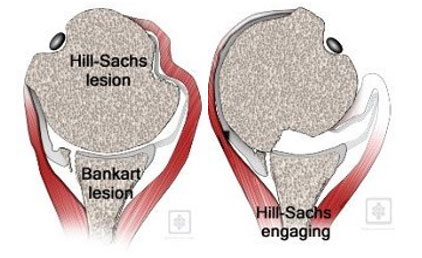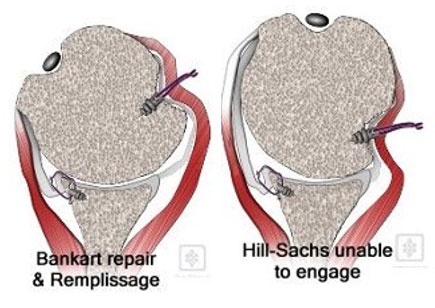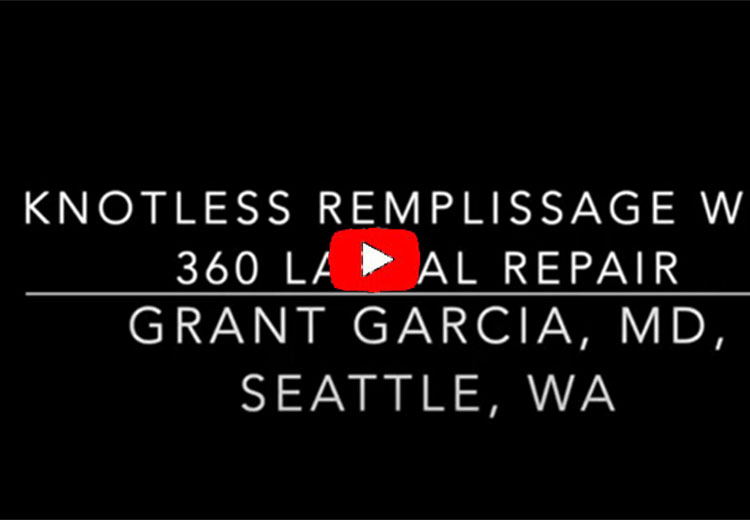Remplissage Technique for Shoulder Instability (Infraspinatus Tenodesis)
Check out Dr. Garcia’s new Remplissage technique with an anterior and posterior labral repair
Introduction:
Among the various procedures available, Remplissage stands out for its exceptional benefits. In this comprehensive article, we will delve into the indications, reasoning for surgery, surgical technique, results, and postoperative rehabilitation associated with the Remplissage procedure.
Indications:

The Remplissage procedure is primarily indicated for patients experiencing shoulder instability, particularly those with recurrent anterior shoulder dislocations or subluxations. It is most effective when there is a concomitant Hill-Sachs lesion—a compression fracture on the humeral head caused by shoulder dislocation. By addressing both instability and the associated Hill-Sachs lesion, Remplissage offers an innovative solution to enhance joint stability and restore normal shoulder function.
Reasoning for Surgery:
Shoulder instability can significantly impact an individual's quality of life, leading to pain, limited mobility, and recurrent dislocations. The primary goal of the Remplissage procedure is to stabilize the shoulder joint and reduce the risk of future dislocations. When a Hill-Sachs lesion is present, the likelihood of recurrent dislocation is higher. Remplissage addresses this by filling the defect with the infraspinatus tendon, effectively preventing the humeral head from engaging the glenoid rim during certain movements.

This technique is preformed when the Hill-Sachs lesion is very large and 'engaging' the anterior glenoid with little overhead movement (i.e. dislocating very easily due to the large Hill-Sachs lesion, as well as the Bankart lesion). In these situations, a Bankart repair alone may not be sufficient. Thus, the development of the remplissage technique.
Dr. Garcia is one of the research pioneers on the Remplissage procedure since 2010 and uses the technique after addressing the Bankart lesion.
Arthroscopic Remplissage W Bankart Technique by Dr. Grant Garcia
Surgical Technique:
Remplissage is typically performed as an arthroscopic procedure under general anesthesia. Small incisions are made to introduce a camera (arthroscope) and specialized instruments into the shoulder joint. The surgeon carefully evaluates the extent of shoulder instability and identifies the Hill-Sachs lesion. To stabilize the joint, the infraspinatus tendon is detached and advanced into the humeral head defect, effectively filling the lesion. Subsequently, the tendon is secured in place using sutures or anchors. This technique not only fills the void but also acts as a barrier, preventing the humeral head from engaging the glenoid rim during certain movements, thus reducing the risk of dislocation.
Results of the Surgery:
The results achieved through Remplissage are highly encouraging. The procedure effectively reduces shoulder instability and minimizes the risk of future dislocations. Studies have shown a significant decrease in recurrent instability and improved patient satisfaction rates following Remplissage surgery. However, it is important to note that individual outcomes may vary depending on the severity of shoulder instability and other factors. Close adherence to the postoperative rehabilitation program is crucial to optimizing the results.
Rehabilitation and Recovery:
Dr. Garcia demonstrates his new advanced technique for Remplissage
Following Remplissage surgery, a comprehensive rehabilitation program is essential for optimal recovery. Physical therapy plays a pivotal role in gradually restoring range of motion, strengthening the shoulder muscles, and improving overall joint stability. The rehabilitation process is typically divided into several phases, with each phase focusing on specific goals and exercises. The duration and intensity of rehabilitation will depend on the patient's progress and individual circumstances.
During the initial phase, the emphasis is on pain management, gentle exercises, and protecting the repaired structures. As healing progresses, the rehabilitation program gradually introduces more challenging exercises to improve range of motion and strength. The goal is to enable patients to regain full functionality and return to their pre-injury activities, including sports and physical exertion.
Conclusion:
For patients struggling with recurrent shoulder dislocations or subluxations, the Remplissage procedure offers significant benefits. Through a minimally invasive approach, it effectively addresses shoulder instability and associated Hill-Sachs lesions, providing long-lasting stability and improved joint function. Make an appointment with Dr. Garcia to see if you are a candidate for this surgery.





















